Archived Water Damage Blog Posts
Spring Clean to Stay Dry: Preventing Flooding in Your Home | SERVPRO of San Diego East
4/7/2025 (Permalink)
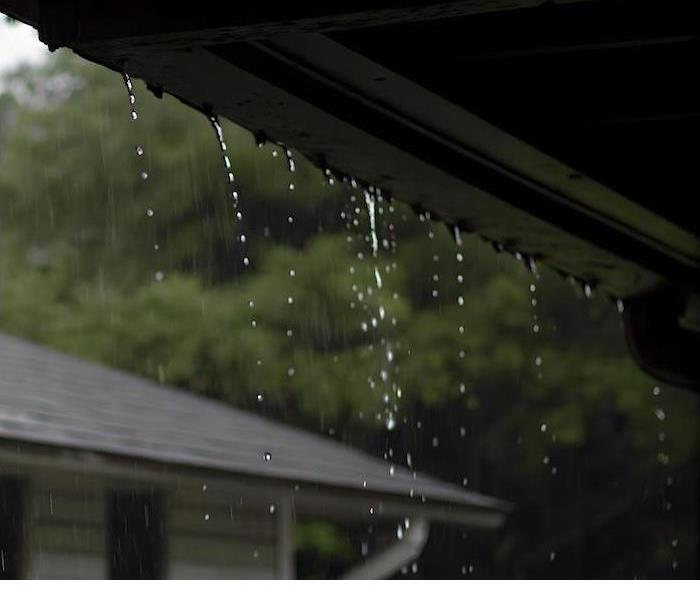 Spring is the time to get ahead of potential flooding risks
Spring is the time to get ahead of potential flooding risks
Spring is here in San Diego, and while the sunny skies are a welcome sight, the rainy weather can bring some unexpected challenges for homeowners. As the season shifts, it’s the perfect time to not only clean out your closets and windows but also make sure your home is safe from potential flooding. SERVPRO® of San Diego East is here to help you prevent flooding caused by common issues like appliance malfunctions, plumbing failures, and leaks—problems that can be even more likely during the spring months.
Understanding the Risks of Spring Flooding in San DiegoSan Diego may not get as much rain as other areas, but the spring showers that roll through can still cause problems for your home, especially when it comes to flooding. Broken pipes, appliance failures, and weather-related leaks are all common issues that can lead to water damage, and the wet season often increases the risk of these events.
Leaks around windows and doors are also more likely when heavy rains hit. Even small leaks can lead to bigger issues, such as mold growth or structural damage if left unchecked. If your home is older or has not been well-maintained, these problems can be even more pronounced, making early detection and action crucial.
How to Prevent Flooding in Your Home This SpringSpring cleaning isn't just about dusting shelves and organizing your garage. It's also about getting ahead of potential flooding risks by ensuring your plumbing, appliances, and home systems are functioning correctly.
Check Appliances and Plumbing: One of the most common causes of internal flooding is malfunctioning appliances like dishwashers, washing machines, and water heaters. Inspect hoses and connections for any signs of wear and tear, and consider replacing old or cracked hoses before they fail.
Clean Gutters and Downspouts: Ensure your gutters are clear of debris, allowing water to flow freely away from your home. Blocked gutters can overflow, potentially leading to water seepage into your basement or foundation.
Inspect the Roof and Foundation: Ensure your roof and foundation are intact. Small cracks or missing shingles may allow water to seep in, leading to flooding in areas like basements or lower levels of your home.
If you notice any issues or aren’t sure where to start, it's a good idea to reach out to professionals like SERVPRO of San Diego East. They can help assess your home’s vulnerability and offer expert advice on preventing flooding before it starts.
Call SERVPRO of San Diego East TodaySpring is the time to get ahead of potential flooding risks. Don't wait for a plumbing issue or leak to cause water damage in your home. Reach out to SERVPRO of San Diego East today to ensure your home is safe and dry all season long. Visit our website for more information
Flood Damage vs. Water Damage: Key Differences
6/12/2024 (Permalink)
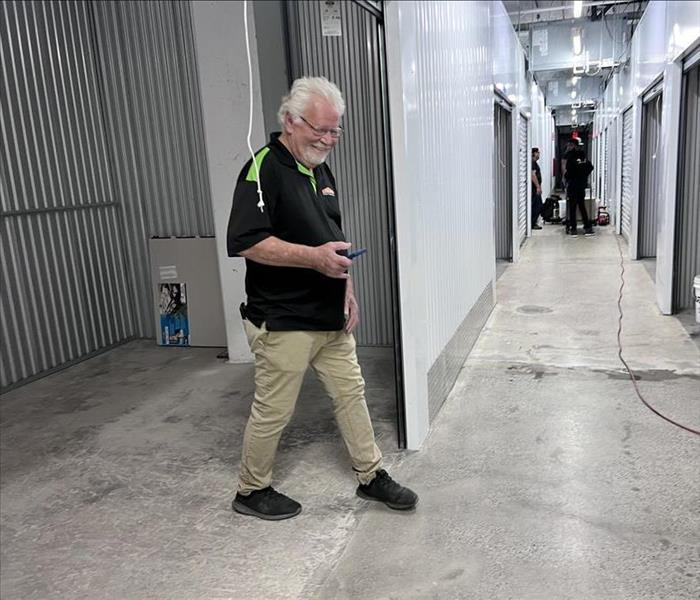 Our team is knowledgeable in the key differences between flood damage and water damage.
Our team is knowledgeable in the key differences between flood damage and water damage.
Water damage is a common issue that homeowners may encounter, whether caused by a burst pipe, leaky roof, or plumbing malfunction. However, when it comes to the extent and severity of damage, there are distinct differences between water damage and flood damage. Understanding these differences is crucial for taking the appropriate actions and seeking professional assistance. In this blog, we will discuss the key differences between flood damage and water damage.
Causes of Damage
One of the primary distinctions between flood damage and water damage lies in their causes. Water damage typically arises from internal sources within the home, such as faulty appliances, burst pipes, or damaged roofs. These incidents are often localized and can affect specific areas or rooms within the property.
On the other hand, flood damage occurs as a result of external water sources, such as heavy rain, rising rivers, or coastal storm surge. Floodwater can infiltrate various parts of the property, affecting multiple rooms or even the entire structure.
Severity and Volume
Flood damage is generally more severe and extensive compared to typical water damage incidents. Floodwater is often widespread, covering large areas and affecting multiple levels of a property. The volume and pressure of floodwater can cause significant damage to walls, foundations, flooring, and other structural elements.
Water damage, while still significant, is usually contained within a specific area or room. The volume of water involved may be smaller, but it can still lead to significant damage if not addressed promptly. However, water damage from sources like burst pipes or malfunctioning appliances can quickly escalate if left unresolved.
Types of Water
The type of water involved in the damage is another critical distinction. Floodwater is classified as Category 3 or black water, which is highly contaminated and poses potential health risks. It can contain sewage, chemicals, debris, and other hazardous substances. Due to its unsanitary nature, professional remediation and proper precautions are necessary when dealing with flood damage.
Water damage from internal sources is typically Category 1 or clean water, which poses minimal health risks. Clean water may come from a broken supply line, faucet, or other freshwater sources. However, if left untreated or unresolved, clean water can become contaminated and escalate to higher categories, requiring more extensive remediation.
Insurance Coverage
Insurance coverage is often another differentiating factor between flood damage and water damage. While standard homeowners' insurance policies usually cover water damage from internal sources, such as burst pipes or plumbing leaks, they may not provide coverage for flood damage.
Flood damage is typically covered under a separate flood insurance policy that homeowners can purchase through the National Flood Insurance Program (NFIP) or private insurers. It's essential for homeowners in flood-prone areas to have flood insurance in place to protect their property from flood-related damages.
Understanding the differences between flood damage and water damage is crucial for homeowners to take appropriate actions and seek professional assistance promptly. Whether dealing with flood damage or water damage, it is essential to engage certified restoration professionals like SERVPRO® for efficient and thorough remediation. If you require assistance with flood or water damage restoration, contact SERVPRO for expert and reliable restoration services tailored to your specific needs.
Everything You Need to Know About Drying Equipment
2/20/2024 (Permalink)
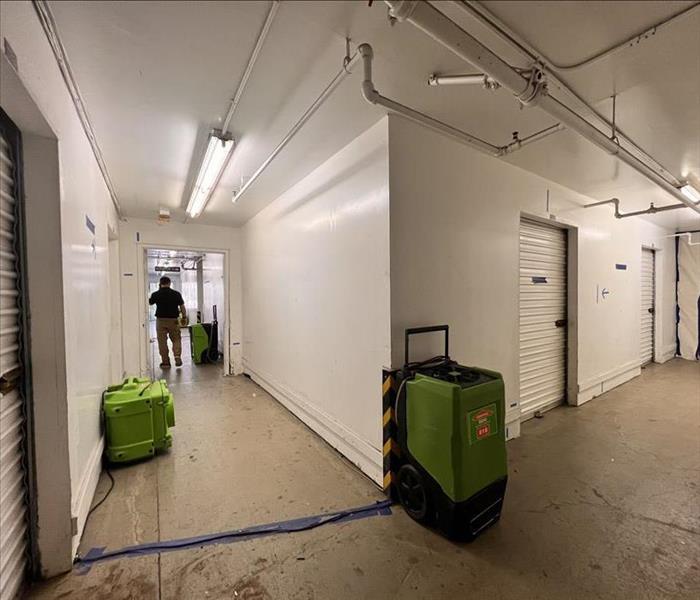 The success of drying techniques lies in the balance of various tools and methods.
The success of drying techniques lies in the balance of various tools and methods.
Water damage can be a homeowner's nightmare, but fear not – efficient drying techniques are the unsung heroes in the battle against water leaks. Let's demystify the workings of essential drying equipment such as air movers and dehumidifiers.
1. Air Movers: The Powerhouse of Evaporation
Air movers, often resembling high-powered fans, play a crucial role in accelerating the evaporation process. By creating a continuous flow of air across wet surfaces, they enhance moisture evaporation, turning water into water vapor. This swift evaporation is essential in preventing stagnant water, minimizing the risk of mold growth, and expediting the overall drying process.
2. Dehumidifiers: Moisture's Nemesis
Dehumidifiers are the heavy lifters in the drying arsenal. These machines work by extracting excess moisture from the air, reducing humidity levels to an optimal range. The process involves pulling in moist air, cooling it to condense the moisture into water, and then releasing the drier air back into the environment. This not only assists in drying surfaces but also prevents secondary issues like mold and mildew.
3. Moisture Meters: Precision in Progress
Precision is crucial in the drying game, and moisture meters are the tools that provide it. These handheld devices measure the moisture content of various materials, helping professionals assess the effectiveness of drying techniques. By pinpointing areas with lingering moisture, technicians can tailor their approach, ensuring a thorough drying process.
4. Desiccants: Absorbing Moisture Like a Sponge
Desiccant dehumidifiers are like moisture-absorbing sponges. These units use a desiccant material, typically silica gel, to absorb moisture from the air. As the desiccant attracts and holds the water vapor, the air becomes drier. Desiccants are especially effective in extremely humid conditions and are often employed in specialized drying situations.
5. Injection Drying: Targeted Precision
Injection drying is a precision technique that involves directing drying air into specific spaces within walls, ceilings, or floors. By creating openings and strategically placing air movers, technicians can target hard-to-reach areas that might be holding onto moisture. This method ensures a more thorough drying process.
In conclusion, the success of drying techniques lies in the balance of various tools and methods. Air movers accelerate evaporation, dehumidifiers wring excess moisture from the air, moisture meters provide precision, desiccants absorb like sponges, and injection drying reaches hidden corners. When orchestrated effectively, these techniques transform a water damage nightmare into a successfully dried and restored space.
5 Steps to Protect Your San Diego Home from Water Damage
10/10/2023 (Permalink)
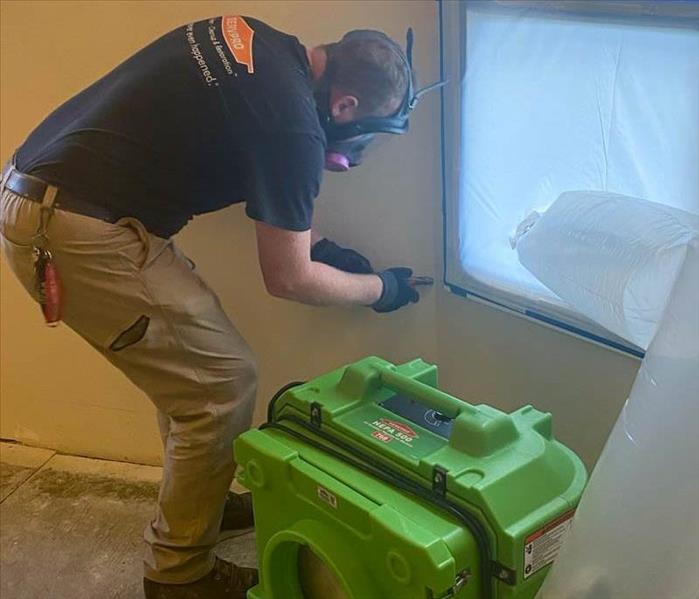 For expert water damage restoration services in San Diego, contact SERVPRO® of San Diego East today.
For expert water damage restoration services in San Diego, contact SERVPRO® of San Diego East today.
As a homeowner in San Diego, protecting your property against water damage is crucial. The city's proximity to the ocean and its susceptibility to rainfall make it susceptible to water-related issues. By enhancing your home's resilience and taking proactive measures, you can minimize the risk of water damage and its costly consequences. In this blog, we will provide you with valuable tips and strategies to safeguard your home against water damage in the beautiful city of San Diego.
1. Regular Roof Maintenance
Your roof is your home's first line of defense against water intrusion. Regular roof inspections and maintenance are essential to identify and address any potential vulnerabilities. Check for damaged or missing shingles, clean gutters, and downspouts regularly, and ensure proper attic ventilation to prevent condensation buildup. Investing in routine roof maintenance can significantly reduce the chances of water leaks during heavy rainstorms.
2. Proper Yard Drainage
San Diego's occasional heavy rainfall can lead to pooling water or flooding in your yard, which can eventually seep into your home's foundation. Ensure that your yard has proper grading to redirect water away from your home's foundation. Consider installing French drains, catch basins, or a rain garden to help manage excess rainwater and prevent water from accumulating near your property.
3. Maintain and Monitor Plumbing Systems
Leaking pipes and plumbing system failures can cause significant water damage if left unattended. Regularly inspect your plumbing for leaks, drips, or signs of corrosion. Ensure that everyone in your household knows the location of the main water shut-off valve in case of emergencies. Consider installing water leak detection systems that can alert you to any water leaks or abnormal usage, providing an early warning system against potential water damage.
4. Waterproofing Basements and Crawl Spaces
If your home has a basement or crawl space, it is important to take measures to prevent water intrusion. Inspect the walls and floors for any cracks or vulnerabilities and seal them with waterproofing materials. Install quality sump pumps and battery backups to prevent basement floods during heavy rainfall or plumbing emergencies. Properly ventilate and dehumidify crawl spaces to prevent moisture buildup and mold growth.
5. Install Flood Prevention Devices
Flash floods can occur during intense rainstorms. Installing flood prevention devices, such as backwater valves and sump pumps with battery backups, can provide additional protection against floodwater backup in your plumbing system. These devices help prevent sewage or stormwater from entering your home, reducing the risk of water damage during a flooding event.
By implementing these strategies, you can protect your property and minimize the potential devastation caused by water-related issues. Remember to prioritize regular roof maintenance, ensure proper yard drainage, monitor your plumbing systems, waterproof basements, and crawl spaces, and install flood prevention devices when necessary. If you do experience water damage despite your best efforts, don't hesitate to contact the water damage restoration experts at SERVPRO® of San Diego East. We are here to help mitigate and restore your property efficiently and effectively.
For expert water damage restoration services in San Diego, contact SERVPRO® of San Diego East today. Our experienced team is available 24/7 to assist you in your time of need.
Water Leaks Uncovered: Protecting Your Business from Costly Losses
7/13/2023 (Permalink)
Water leaks can wreak havoc on businesses, causing significant damage, financial losses, and disruptions to operations. Whether it's a burst pipe, faulty plumbing, or a leaky roof, water leaks pose a considerable risk to commercial properties. In this blog post, we will explore the impact of water leaks as the most common business losses and provide practical tips to prevent them. By understanding the risks and implementing preventive measures, businesses can safeguard their assets and minimize the potential for water-related disasters.
The Costly Consequences of Water Leaks
Water leaks in commercial properties can lead to various detrimental consequences. These include property damage, loss of inventory, equipment malfunction or damage, structural deterioration, mold growth, and potential health hazards for employees and customers. Additionally, business interruptions due to water damage can result in lost productivity, revenue, and customer trust.
Common Causes
Understanding the common causes of water leaks is crucial for prevention. Faulty plumbing, aging infrastructure, burst pipes, damaged or poorly maintained roofs, leaking appliances or fixtures, and inadequate drainage systems are some of the common culprits. Regular inspections and maintenance can help identify potential issues before they escalate into costly leaks.
Conduct Regular Inspections
Establish a proactive approach to identify and address water leak risks. Regularly inspect plumbing systems, including pipes, valves, and connections, to detect any signs of leaks or damage. Inspect the roof for cracks, missing shingles, or damaged flashing that could lead to water infiltration. Pay attention to areas prone to moisture, such as basements, bathrooms, kitchens, and utility rooms.
Maintain Plumbing Systems
Routine maintenance is essential to keep plumbing systems in optimal condition. Schedule regular inspections and maintenance with licensed plumbers to address any potential issues promptly. Replace worn-out parts, repair leaks, and ensure proper insulation to prevent freezing pipes in colder climates. Educate employees about reporting any signs of leaks or plumbing problems.
Ensure Adequate Drainage
Poor drainage systems can contribute to water leaks and damage. Regularly inspect and clear gutters, downspouts, and drains to prevent clogs and water buildup. Ensure that water flows away from the building's foundation to minimize the risk of water seepage.
Install Leak Detection Systems
Invest in advanced leak detection systems to monitor water usage and detect leaks in real-time. These systems can automatically shut off the water supply or send alerts when abnormal water flow or leaks are detected. Early detection can significantly reduce the extent of damage and mitigate losses.
Educate Employees
Raise awareness among employees about the importance of water conservation, leak detection, and reporting. Encourage them to promptly report any signs of leaks or water-related issues they notice. Training employees on basic water management practices, such as turning off faucets tightly and reporting dripping fixtures, can contribute to leak prevention efforts.
Review and Update Insurance Coverage
Regularly review your insurance coverage to ensure it adequately protects your business against water-related losses. Understand the scope of coverage for water damage and any specific exclusions or limitations. Consider additional endorsements or riders to your policy if necessary to enhance protection.
Develop a Water Emergency Plan
Prepare a comprehensive water emergency plan that outlines the steps to be taken in the event of a water leak or flood. Designate responsible personnel to handle emergency situations, including contacting appropriate professionals and coordinating cleanup and repairs. Ensure the plan is accessible and known to all employees.
Water leaks pose a significant risk to businesses, causing extensive damage and financial losses. By understanding the common causes of leaks and implementing preventive measures, businesses can reduce the likelihood of water-related disasters. Conduct regular inspections, maintain plumbing systems, ensure proper drainage, install leak detection systems, educate employees, review insurance coverage, develop a water emergency plan, and seek professional assistance when needed. Taking these proactive steps will help businesses protect their assets, maintain continuity, and minimize the impact of water leaks as common business losses. Engage the services of professional water damage restoration companies to handle any water leaks or damage promptly and effectively. These experts have the expertise, equipment, and experience to mitigate the damage, restore affected areas, and minimize business disruptions.
Accidental Fire Sprinkler Activation
3/8/2023 (Permalink)
It's a scary thing when the fire sprinklers go off at your place of business. You're probably wondering if you'll ever get things back to normal. Luckily, there are some steps you can take that will help minimize the damage and get things back to normal as quickly as possible.
Where did the fire sprinklers go off?
If you're like most people, the first thing you'll want to know is where the water came from. In many cases, it's clear that a fire sprinkler has gone off. If there's no visible sign of damage or flooding and only one or two sprinklers have been activated, then it's likely that the cause was an accidental activation.
What is the source of the water? A simple way to determine whether your facility has been affected by an accidental activation is by checking for signs of damage in areas where sprinklers should not be installed. Electrical panels or air conditioning units, and seeing if any of these items have been damaged by dripping water. What are the consequences of this loss? The amount of damage will vary depending on how much water was lost through each individual sprinkler head during its cycle.
How much water has been lost?
The amount of water lost will depend on the type of sprinkler system and how long it was in operation. If you don't know how much water has been lost, contact your fire protection company immediately.
Was the loss intentional or accidental?
If the fire sprinklers went off accidentally, you should call a professional to assess the damage. The person who turned them on may or may not be liable for any associated costs and damages. If they were intentionally activated and there is no fire, then you should also call the fire department immediately as well.
Getting things back to normal as quickly as possible?
First thing to get things back to normal quick is call the fire department. Upon arrival call a restoration company to quickly access the damage. Turn off all power to your building and shut off water to affected areas. Remove all valuables from affected areas, including computers, paperwork and anything else that might be damaged by water or fire.
Clean up any standing water with towels or mops, and use air movers and dehumidifiers to help reduce water damage and potential secondary damages.
Plan in place
If you have fire sprinklers in your building, you should have a plan in place to deal with them. This can include things like, having someone who is responsible for checking the water levels on a regular basis and making sure they're not getting too low, especially during times when there are fewer people working at the office or school.
Keeping an eye out for any signs that something might be wrong with a sprinkler (like leaks) so that it can be fixed before there's any damage done to anything else nearby.
Having someone ready to turn off all power sources if they feel unsafe while working near water levels that are too high due to malfunctioning equipment or other issues related directly back up into their electrical systems. You'll want everyone working together so everyone knows what needs doing immediately after hearing those fateful words "Fire Sprinklers Activated."
In the event of an accidental fire sprinkler activation, you should survey the damage and determine whether or not it was intentional. If it was, then you should call 911 immediately and let them know. If it wasn't intentional then there may be some steps that can be taken by yourself or with help from professionals to clean up the mess and restore things back to normal as quickly as possible.
Cleaning Up Water Damage In Your Home
11/1/2022 (Permalink)
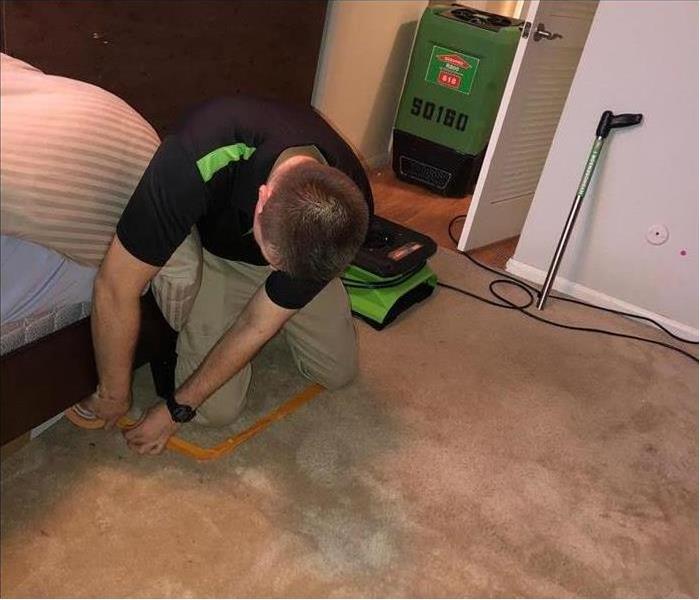 San Diego water damage
San Diego water damage
Water Damage Tips
Water damage is a serious problem that can strike at any time and cause costly, long-term damage to your home. If you've ever had to deal with water damage in your house, you know how quickly things can go from bad to worse if you don't act fast. So, what steps should you take after a pipe breaks or an appliance starts leaking? Here's what you need to know about cleaning up water damage in your home!
Water damage is a serious problem that can strike at any time. Is your home prepared?
Have you ever wondered what to do if you suspect water damage? If you have, then this expert guide will help.
What to Do if You Suspect Water Damage:
- Check the ceiling and walls for signs of moisture or discoloration. If they're wet or showing signs of mold, it's time to call in professionals like our team at SERVPRO. We'll assess your situation and let you know how best to proceed.
- Never use hot water extraction methods on your own; these methods aren't safe for untrained individuals who don't have access to the proper equipment and training required for their execution.
If a pipe in your house breaks, turn off your water supply at the main valve right away to stop further water damage.
Here are some tips from the pros on how to deal with a water emergency in your home:
- Turn off your water supply. If a pipe in your house breaks, turn off your water supply at the main valve right away to stop further water damage.
- Turn off the heater. If you have a gas-heated home, it's important to shut off or reduce power (if possible) to any heaters that may be affected by the flooding.
- Shut down electrical appliances in affected areas. It’s often not safe for you or anyone else to be around electrical equipment during cleanup because of potential electrical hazards like live wires and short circuits – so let professionals handle those repairs.
- Don't turn on any faucets until after they're dried out completely; this will help prevent any bacteria growth inside of them while they're still wet.
Don't hesitate to call a professional for help. It's better safe than sorry when it comes to water damage.
When you have a water damage issue, it's tempting to try and tackle things yourself. But it's important to realize that you may not be able to tell the extent of the damage or what kind of long-term effects there might be from water lingering in your home. It's better to be safe than sorry by calling a professional who can help resolve the problem for you and make sure everything is resolved properly.
Professional water damage cleanup is the way to go after any major leak or flood situation.
After a flood or leak, it's important to get the job done as quickly and efficiently as possible to prevent further damage. Professional water damage clean-up services are equipped with the tools and knowledge necessary to remove all your worries about the cost or time it will take to fix your property. If you choose not to hire a professional service, you may end up spending much more money on repairs than you would have by calling in the pros.
It is also important that you take care of any mold problems before they happen so that they don't spread throughout your home or office space. If left unchecked, mold can cause serious health problems such as respiratory issues and even death in some cases!
We hope this article has been helpful, and we wish you the best of luck in keeping your home safe from water damage. If you have further questions or concerns about any aspect of water damage repair, please contact us.
Understanding Category Three Water Damage
5/25/2022 (Permalink)
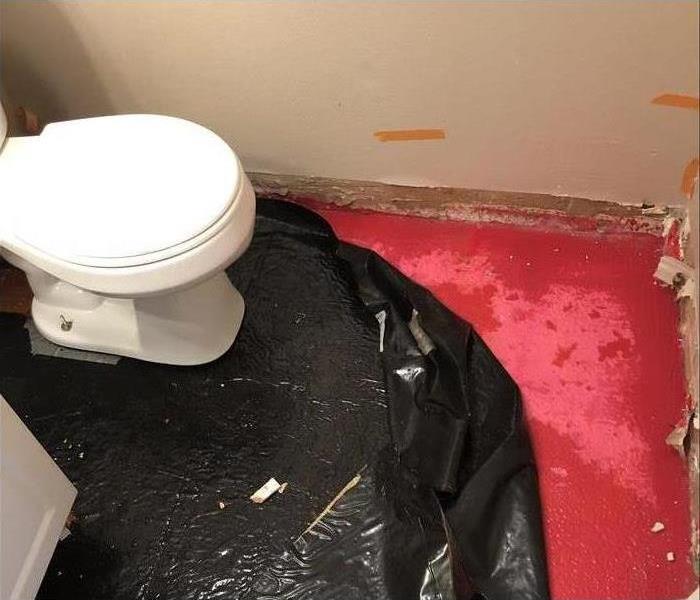 Cleaning up water from the third category is best left to the experts.
Cleaning up water from the third category is best left to the experts.
Water damage to your College East, CA, home is classified into three categories. If this is the first time you've experienced such damage at your residence, you may have heard terms like black water and gray water but are unsure what they mean.
Water Damage Categories
The three categories of water damage are:
Category 1: This category includes water that is considered clean because it does not have contaminants. Examples of category one water damage are a leaking water supply line or an overflowing sink.
Category 2: This water classification is also known as gray water. Examples are water from sump pumps or washing machines.
Category 3: Also known as black water, this category includes storm surge, sewage water, seawater, standing water and ground surface water. Gray water can enter this category if it remains stagnant.
Sewage Cleanup
Cleaning up water from the third category is best left to the experts. A professional remediation company can remove this type of water from your home and ensure that the job is done safely. Porous materials such as drywall, carpet and wood can absorb water fast. Professional technicians have the knowledge and equipment needed to dry out the water as quickly as possible. They can also repair damage and replace materials where necessary, leaving you with a clean, dry home.
A remediation company sends technicians to your house to assess the situation and explain the level of damage to you. They can help you stop the source of the problem if it is ongoing. Technicians then use extraction equipment and industrial dryers to remove water. Once the area is dry, they implement special equipment to sanitize and deodorize your home.
If you have black water damage in your College East, CA, home, it's a good idea to call a professional to help with cleanup. It's the safest and easiest way to repair the damage and get back to normal quickly.
The Challenge of Fixing Water Damage in Your Home
5/18/2022 (Permalink)
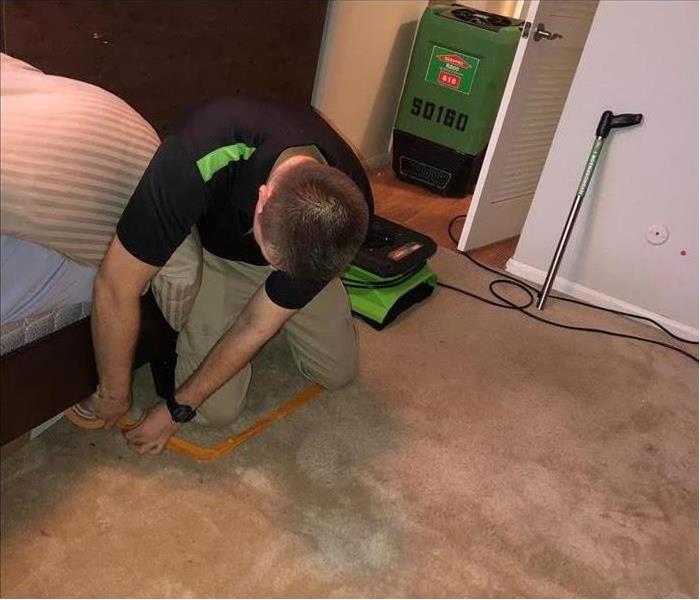 Water damage in a home in College West, CA.
Water damage in a home in College West, CA.
The Problem with Water Damage in Your Home
Your home in College West, CA, has a long list of items you probably would not want to see drenched with water. This makes unwanted water in the home a decidedly unpleasant event. Of course, these things do happen, so it is best to take appropriate action and make the best of things. If the situation involves a large degree of clean water or even a small amount of dirty water, calling for the services of a water damage mitigation franchise should be one of your first actions. A trained team can help you meet a host of challenges
Dealing With a Broken Pipe
When a pipe burst, hundreds if not thousands of gallons of water are likely to spread into your home. This water could drench furniture, clothes, and other personal items, even including paintings, paperwork and fabrics. The solution is not to throw out everything, as that could get expensive. Plus, with the right equipment, many items could be saved. After water in a home disaster, experienced technicians will use advanced techniques to restore items:
- Dry cleaning
- Immersive cleaning
- Abrasive cleaning
- Off-site cleaning and restoration
By using the right techniques for specified items, damage can be minimized. In some scenarios, family heirlooms and other valuable personal items can be restored to excellent condition. While most people do not have the skill and equipment to restore items, a professional franchise uses the best practices of the cleaning and restoration industry.
Recovering From a Water Spill
With water damage, a job that is not done perfectly could lead to additional heartaches. Insufficient drying could lead to mold growth down the road. Improper cleaning could lead to unpleasant smells that permeate your house. For these reasons, it is important to monitor the situation after a water spill.
A water-in-home situation presents many challenges to the cleanliness of your home. Taking the appropriate steps will allow you to move on with few if any worries.
Tips To Protect Your Business From Disaster
3/31/2022 (Permalink)
Disaster Preparedness Tips for Your Business
When severe weather strikes, you are undoubtedly worried about protecting your business. A tornado, hurricane or severe downpour can cause flooding and physical damage to your building and affect your ability to sustain your regular business practices. Designing a custom emergency response plan can be invaluable if your San Carlos, CA, business experiences a serious disruption.
Your Business Continuity Plan
Having a plan that addresses all types of potential damage is essential to your company’s risk-management strategy. These steps may help you create a solid plan that protects you.
Identify the risks particular to your business, such as a nearby flood plain, coastal hurricane vulnerability or a basement that often floods.
Assess the potential impacts on your staff, your property and your daily operations for each risk category.
Outline preventive measures that address each risk area, such as flood-prevention maintenance or fire-safety planning.
Formulate the specific steps to be followed by you and your staff in case of an emergency.
Regularly review, update and test your business continuity plan with live drills.
A well-designed plan can give you and your workforce a better chance of working together to prevent damage and minimize property loss.
Emergency Preparedness Tips
As part of your plan, you may want to keep an emergency kit on site. The kit might include items such as water, flashlights, extra batteries, protein bars, and a medical first-aid kit. It is also important to make sure you have fire extinguishers placed throughout your building. Many businesses find that a local fire department or disaster remediation service will happily offer your staff trainings in fire extinguisher operation, evacuation procedures and other preventive measures. For more detailed information about continuity planning and disaster preparedness, you can consult government resources like Health and Human Services or Federal Emergency Management Agency.
This brief overview may help you formulate a business continuity plan that can both protect your business and your peace of mind. Disaster preparedness may not be at the top of your list, but it can make a big difference when your property and your bottom line are threatened by an emergency.
How Do Experts Clean Up Sewer Damage?
2/18/2022 (Permalink)
 When you find sewage in your commercial property, be sure to call the trained experts at SERVPRO for cleanup and restoration services.
When you find sewage in your commercial property, be sure to call the trained experts at SERVPRO for cleanup and restoration services.
How Do Professionals Repair Sewer Damage?
Water leaks in a commercial property can be either uncontaminated, such as a leak that originates from a broken supply line, or contaminated gray from flooded toilets or a sewer backup. Sewer cleanup involves contaminated water that may contain potentially dangerous substances such as chemicals or microbes and should be performed by certified professionals. Cleanup and restoration experts will follow several steps in commercial properties that have recently experienced a leak involving contaminated water.
1. Contain the leak and remove water and sewage: Cleanup experts will remove excess water and any traces of solid waste from the affected area to prevent water and sewage damage from spreading or worsening.
2. Clean and disinfect the affected area: Professionals use industrial-grade sewer cleanup equipment and may depend on pump sprayers or foggers to eliminate the presence of dangerous bacteria.
3. Dispose of ruined contents: Any materials that cannot be cleaned and decontaminated should be removed as soon as possible and replaced.
4. Drying and decontamination: Experts will thoroughly dry the affected area and decontaminate items that are capable of being salvaged.
5. Restore the area and contents: Restore the cleaned, disinfected, and dried area and contents to pre-damage conditions.
As soon as a commercial property experiences a sewage leak, you should call a plumber and address the source of the problem. Once the leak has stopped, contact a company that specializes in cleaning up sewer damage in commercial properties.
You can depend on the expertise of a certified sewer cleanup service to ensure that your facility is cleaned, disinfected, and dried in compliance with health and safety standards. If you are dealing with a sewage leak in a commercial property located in San Diego, CA, a sewer damage restoration company can help you ensure that your commercial structure is clean, dry, free of mold, and safe for tenants and visitors.
Protect Your Home From Water Damage While You Are on Vacation
1/29/2022 (Permalink)
The second most common cause for claims made against homeowners insurance in San Diego, CA, is water damage, causing damage in the millions of dollars every year. You may not need to do a water pipe repair, but you can help prevent such a disaster from happening in your home while you are away on vacation by taking stock of a few things and performing a few preventive measures.
Steps To Prevent Leaks While on Vacation
•Check all exposed pipes, including under sinks, for leaks and wetness
•Look at connection tubes and supply lines on washing machines, dishwasher, ice maker and so on
•Make sure any exposed pipes are insulated or have heat tape to prevent a pipe burst
•If you plan to turn the heat down while you are away, leave it high enough to keep pipes warm. Leave cabinet doors open under sinks.
After relaxing on vacation, the last thing you want to come home to is a frozen pipe or leak of some kind that has been causing damage since you left. Wet carpets and flooring left to sit can also damage subflooring and can grow bacteria and mold. Broken pipes inside of walls can produce enough water to disintegrate sheetrock, warp and weaken studs, and ruin electrical wiring. Even furnishings and other belongings can suffer water damage if left to sit in wet or damp circumstances.
Water pipe repair can be expensive in San Diego, CA, as can reclamation of your home and belongings. You may feel helpless and not know where to start. Get some help with your water damage repair process from professionals who understand what is needed and have the proper equipment for water removal and dehumidification. They can help check all sources of water in your home and make sure any necessary water pipe repair is done.
Fortunately, much of this damage can be prevented simply by taking the precautions listed above. You can take your next vacation worry-free and come home relaxed to a home where everything is intact.






 24/7 Emergency Service
24/7 Emergency Service







